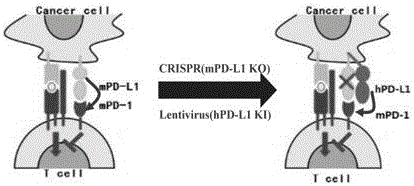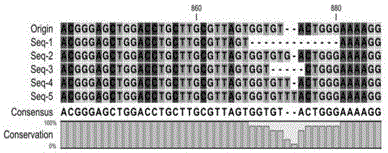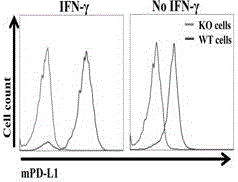Humanized PD-L1 tumor cell line, animal model with same and application of humanized PD-L1 tumor cell line and animal model
A technology of PD-L1 and tumor cells, applied in the field of biomedicine, can solve the problems of long time-consuming and high cost of humanized mice, achieve strong killing and proliferation ability, and reduce economic expenditure
- Summary
- Abstract
- Description
- Claims
- Application Information
AI Technical Summary
Problems solved by technology
Method used
Image
Examples
Embodiment Construction
[0047] Knockout of murine PD-L1 and expression of human PD-L1 in colon cancer cells MC-38.
[0048] Studies have shown that PD-L1 expressed on the surface of tumor cells in tumor tissue acts as an anti-tumor suppressor molecule 20 . This discovery prompted us to establish a more direct and economical animal model. The method of establishing the model is as follows: figure 1 Shown:
[0049] Step 1: Knock out mouse-derived PD-L1 (mPD-L1) through CRISPR-Cas9: According to CRISPR-Cas9 technology, first design a short-chain guide RNA (sgRNA) through the http: / / crispr.mit.edu website , the design sequence is as follows: 5'-GCTTGCGTTAGTGGTGTACT-3'. The synthesized DNA duplex was inserted into the sgRNA expression vector (FG-BB-U6-sgRNA) through BbsI. Then co-transfect MC-38 cells with the Cas9 expression plasmid (FG-hEF / HTLV-Cas9-PGK-Puro-WPRE), and select with puro for 48 hours after 48 hours.
[0050]Then expand the culture, obtain the knockout cell bank, extract the DNA and p...
PUM
 Login to View More
Login to View More Abstract
Description
Claims
Application Information
 Login to View More
Login to View More - R&D
- Intellectual Property
- Life Sciences
- Materials
- Tech Scout
- Unparalleled Data Quality
- Higher Quality Content
- 60% Fewer Hallucinations
Browse by: Latest US Patents, China's latest patents, Technical Efficacy Thesaurus, Application Domain, Technology Topic, Popular Technical Reports.
© 2025 PatSnap. All rights reserved.Legal|Privacy policy|Modern Slavery Act Transparency Statement|Sitemap|About US| Contact US: help@patsnap.com



